This is what happened when I tried to do a marathon with barely any training
Andrew Griffin hated running and didn’t do it – so choosing to compete in a 26-mile race in just a fraction of the normal training time genuinely seemed like a stupid idea...


Your support helps us to tell the story
From reproductive rights to climate change to Big Tech, The Independent is on the ground when the story is developing. Whether it's investigating the financials of Elon Musk's pro-Trump PAC or producing our latest documentary, 'The A Word', which shines a light on the American women fighting for reproductive rights, we know how important it is to parse out the facts from the messaging.
At such a critical moment in US history, we need reporters on the ground. Your donation allows us to keep sending journalists to speak to both sides of the story.
The Independent is trusted by Americans across the entire political spectrum. And unlike many other quality news outlets, we choose not to lock Americans out of our reporting and analysis with paywalls. We believe quality journalism should be available to everyone, paid for by those who can afford it.
Your support makes all the difference.I am stood in Berlin’s Tiergarten, quaking at the beginning of my first marathon. Seven weeks ago, I barely ran at all; the odd short jog was the longest I’d ever run, and every attempt to get into running was proof that I hated it. Four or five hours from now, I hope to be crossing the finish line after running 26.2 miles: a distance that could be much greater than the sum total of all the running I've ever done before.
They say that during endurance events, when you’re pushing your body and mind to their furthest, it can be good to rely on mantras: simple statements that remind you why you are suffering so much. As I await the starting gun, a phrase does bounce around my head: “This is stupid. This is ridiculous.” It will eventually disappear, at the point in the run when even forming words into sentences will feel like an indulgent use of what little energy I still have left.
Over the four hours and 20 minutes that followed, I experienced some of the sharpest pain, deepest despair and most ecstatic joy of my life. But that was at the end of the journey, and on to a new life of running for fun. Through it, I came to think that maybe, on a good day, I might even call myself a runner.
It is hard to exaggerate just how far I was from being a runner when all this started. The longest I had ever run was 5K. What’s more, I didn't like running, no matter how hard I tried; every so often I would lace up my old shoes, plod out of the house, get less than a mile in and wonder why I was bothering, especially when there are many more fulfilling ways of exercising.
Before last summer, I had never participated in any kind of race at all. But at the end of July, I had completed a triathlon after two weeks of training. At the end of it came the run – which ended up more like a walk, really. But afterwards I realised something about it appealed to me. The excruciating fun of doing something I hated and was unprepared for turned out to be something of a thrill. The difficulty felt like a challenge.
So when an invitation to do the Berlin Marathon dropped into my inbox a couple of weeks later, it felt like a twist of fate. After the triathlon, hadn’t I been saying that I should start running, precisely because I hated it so much? The joy of the triathlon had been that I exceeded my limits. It felt necessary to find out again where those limits might lie – undertaking one of the most intense challenges there is, with basically no training. There was a very good chance that I would not only fail but embarrass and hurt myself in the process. There was no reason to do it and plenty of reasons not to. So I said yes.
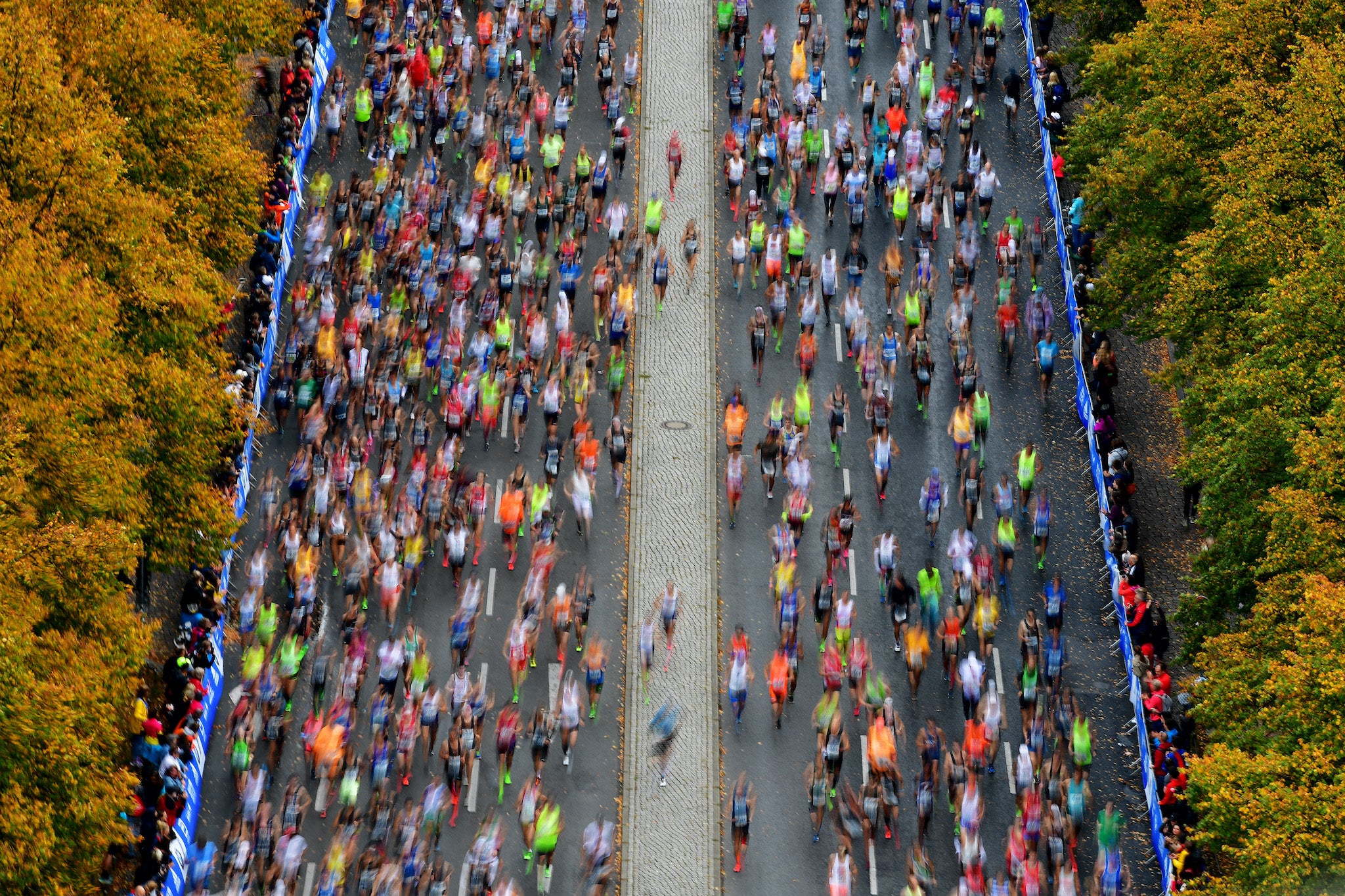
Marathon training is supposed to take at least 20 weeks or more, and that is for someone who has run before. Doing it in seven weeks from a standing start means running a lot. It means running hard and easy, long and short. When you are good at running, this becomes a little more granular, but I don’t even know what speed I’m aiming for and so my runs are marked hard and easy. (Though, of course, they are all hard.)
The training plan becomes a comfort, something to stop me worrying when the race seems too daunting. This happens often, as I count down the days to the race and picture myself keeled over in the middle of a Berlin street. This anxiety feels inevitable, but there is something equally inescapable about the training plan: if I follow it, then I have done everything I can; if I do everything I can, then I can’t regret what comes at the end.
In the most intense training week, I run about 40 miles. This is low for even committed amateurs training for a marathon; but it’s worth remembering that each of those miles took considerably longer than they would for anyone who was actually good at running.
***
I come to realise that running the marathon is not always about running fast or hard. Two pairs of trainers would carry me through: a pair of fast running shoes for the quick runs, but also Nike’s new Joyrides. (A big part of running is talking about trainers; thankfully I’m fairly practised at this bit.) The Joyrides feature a squishy sole, made of a huge array of beads, which are intended to cushion your foot and absorb the impact when it hits the ground, making your runs softer.
This seems strange, given that running is about going fast, and that softness means some of the bounce that would normally be transferred back into your feet is instead eaten up by the shoe. But this is the point: training is not just about running hard but running easy, too. Your body needs to slow down the pace and reduce the intensity while keeping your feet turning over.
Similarly, a great deal of getting ready to run this far isn’t running at all. Recovery is when the real work of getting fitter happens. It’s during that time of not running that your body adapts to all of the stresses that you have put on it, growing muscles and strengthening. So lying down becomes a key part of my workout regime, and I am unexpectedly upset about it. Before I started all of this, resting and feeling good about it would have been my dream. But when you’re training it increases the stress, because time spent lying down is time when you’re not getting fitter.
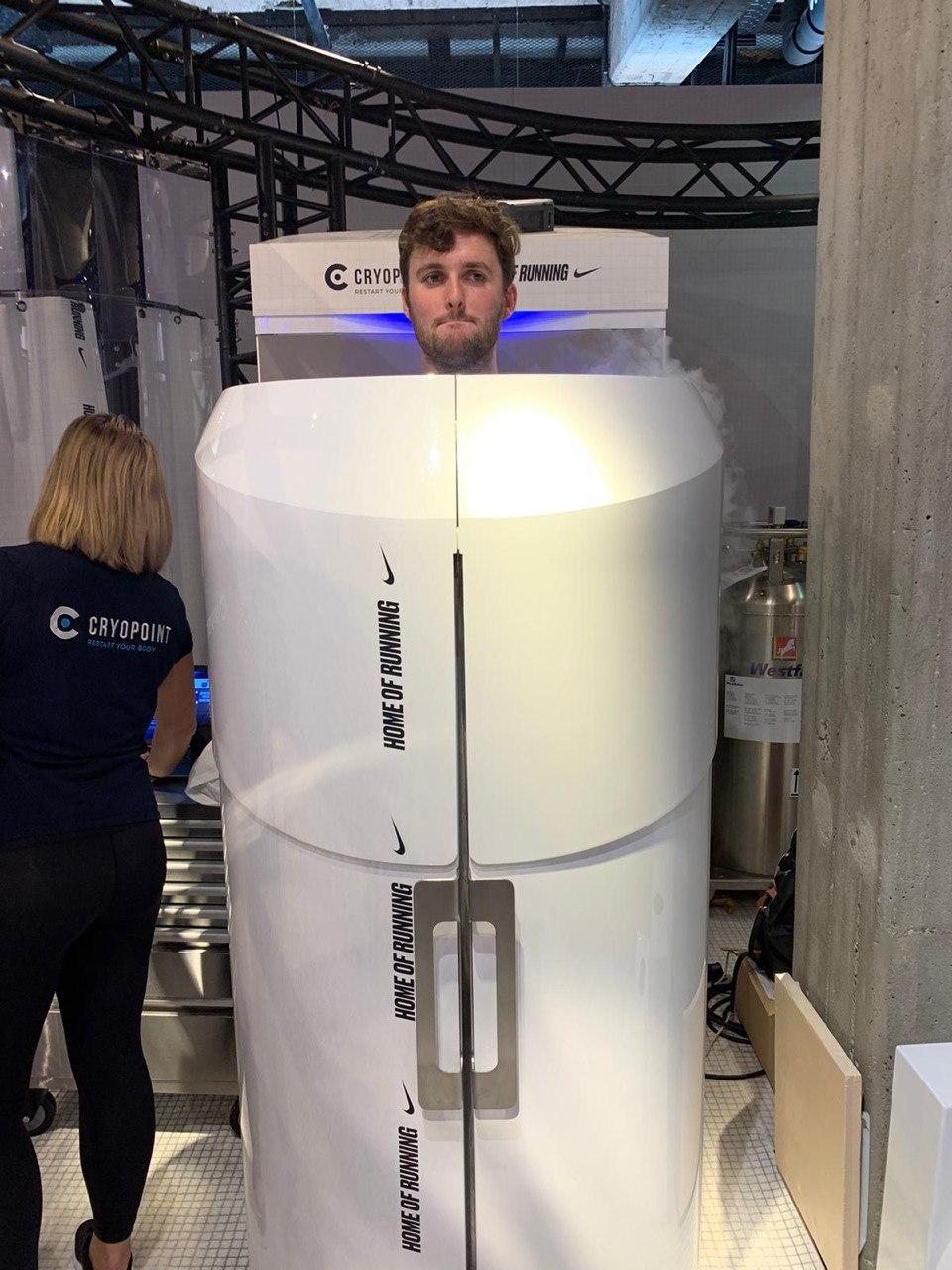
The fact is you have little choice. Training for a marathon in this kind of time limit means being tired all the time. It is a good kind of tired, but it is tiredness all the same. The importance of rest is paramount. But, it turns out, from the most elite runners to myself, your body knows all, and won’t let you forget it.
I train with Luke Worthington, a personal trainer who works with Nike – which organised the trip to Berlin – and some of the world’s best athletes. And now me. He's constructed the running plan but most of the work is in the gym. It is important to ensure your body can take the stresses and strains of training. A common problem among marathon runners is the injury that hits them during the training process and slows them down or even forces them out of the race entirely. If your body is not properly prepared for the stress you’re putting it under, training for the marathon will ruin your marathon.
We take a look around the gym and he asks me to point out anything I don’t recognise. I don’t recognise anything. We begin a little daunted
Luke explains that his normal training process is made up of three segments. The first would be to get ready for the challenge; the second would be to get you strong; the third would turn the training into a run. Because of the time constraints, I won’t be able to do the middle bit.
I am as new to the gym as to running. Luke says we’ll take a look around the gym and I can point out anything I don’t recognise. I don’t recognise anything. We begin a little daunted. But we get to work: lifting, pulling and pushing various weights, as well as balancing out the in-built lopsidedness of my body. I can feel the improvements immediately; the runs hurt less, I stand up taller, and I’m starting to feel prepared.
We squat with weights, which hardens up my knees and legs. Other moves ensure my body is properly aligned, so all parts are sharing the load equally. Before each run, I have to stretch to get me lined up. It works. I remain miraculously uninjured throughout the process. This shocks me but it doesn’t surprise Luke, who remarks that this is the point, and that those injured runners you see limping through the marathon might not need the straps and tape if they'd been to the gym.
Having someone to do this with is obviously ideal, especially since the complexities of biomechanics mean it is hard to keep yourself in check. But while strength training is an often neglected necessity for running a marathon, stumping up for a personal trainer isn’t: a wide variety of apps from Peloton to Nike Training Club offer strength programmes for runners, and there are a host of readily accessible workouts on YouTube. Once again, it turns out, a large part of the real work of a marathon isn’t about being on your feet; it’s making sure you’re ready for when you are.
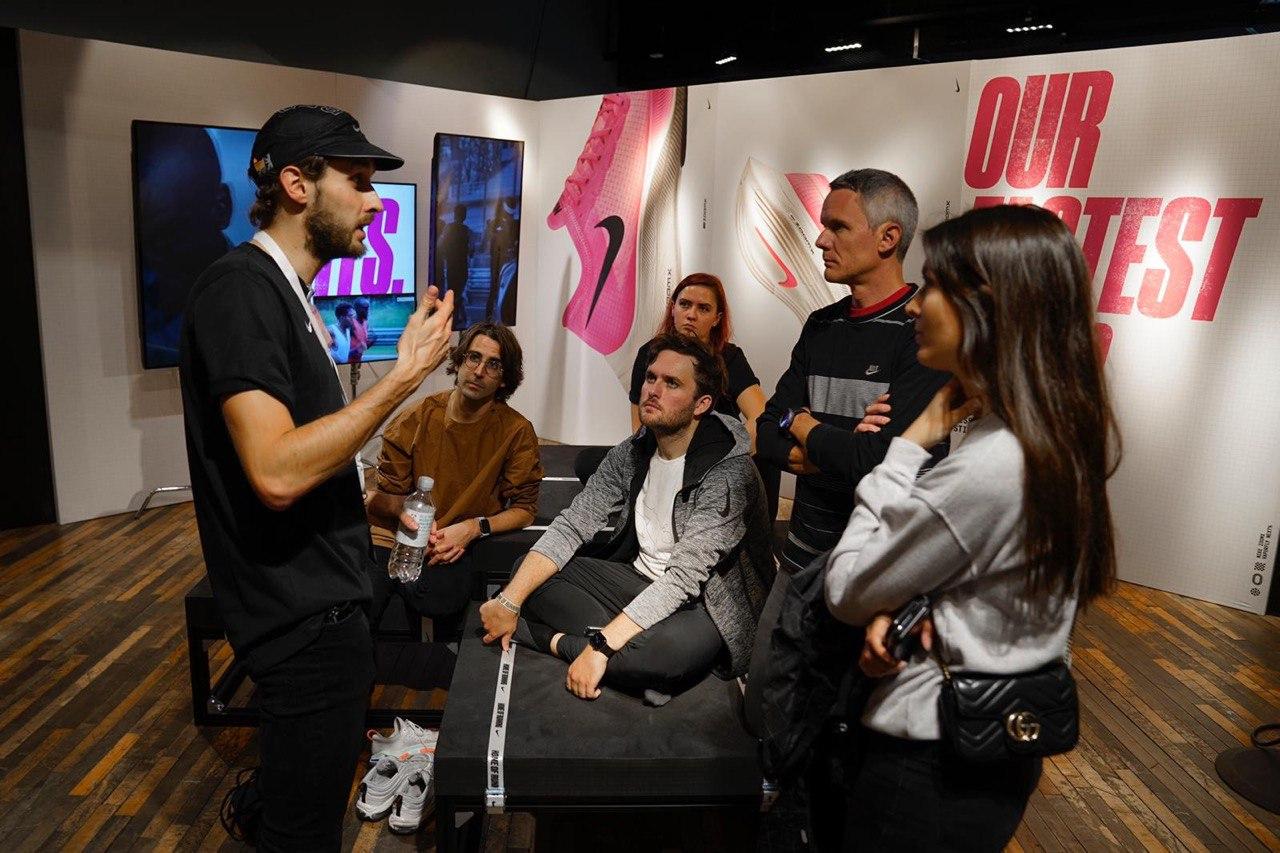
Still, there is no substitute for the time spent running. And there is no solution for the gruelling misery it brings. If there’s one thing I wish people had told me before all of this started, it is this: you too are going to hate it, at first. Eventually, you might get those glimpses of joy that runners talk about. But first, to get there, you must suffer: the first runs will not be pleasant. They probably won’t even be runs, but rather frustrated trudges.
Practically, that means starting small and starting slow. Set reasonable targets and celebrate yourself for reaching them, rather than beating yourself up over how much further you have to go. And so I begin: The first Saturday I had to run 18 miles, more than anything I had ever done before this point. The logic is that running this far is a test to see whether you’ll be able to make it round the course: if you can get to 18 miles, then the energy of the event, of the crowds, of the expectation will carry you through the remaining eight. So I run through the dark of London, gradually inducting myself into the “long run”, which it turns out is something of an article of faith for long runners. Like any religion, it’s in the suffering where grace is found.
My first long runs are all suffering, no grace. There is one particularly hellish 20-mile run – over a blazing hot bank holiday weekend, in hilly Shropshire, visiting my partner’s mum – that begins deceptively easily. I am self-satisfied, running through the beauty of nature, taking selfies of my reddened face to show off how virtuous I was being.
Then it falls apart. It becomes a whir of hills, heat and horror. At one point I am forced to pause my running watch and sit miserably on a wall, having had it confirmed at last that this was a ridiculous idea. In the end, I manage 19.5 miles and it takes me more than five hours. When I get back, I am handed a refreshing smoothie and advice from my partner’s Ironman-completing sister that this will be nowhere near as hard as the actual marathon. This seems undeniably true: it is hard to imagine that anything could possibly be worse.
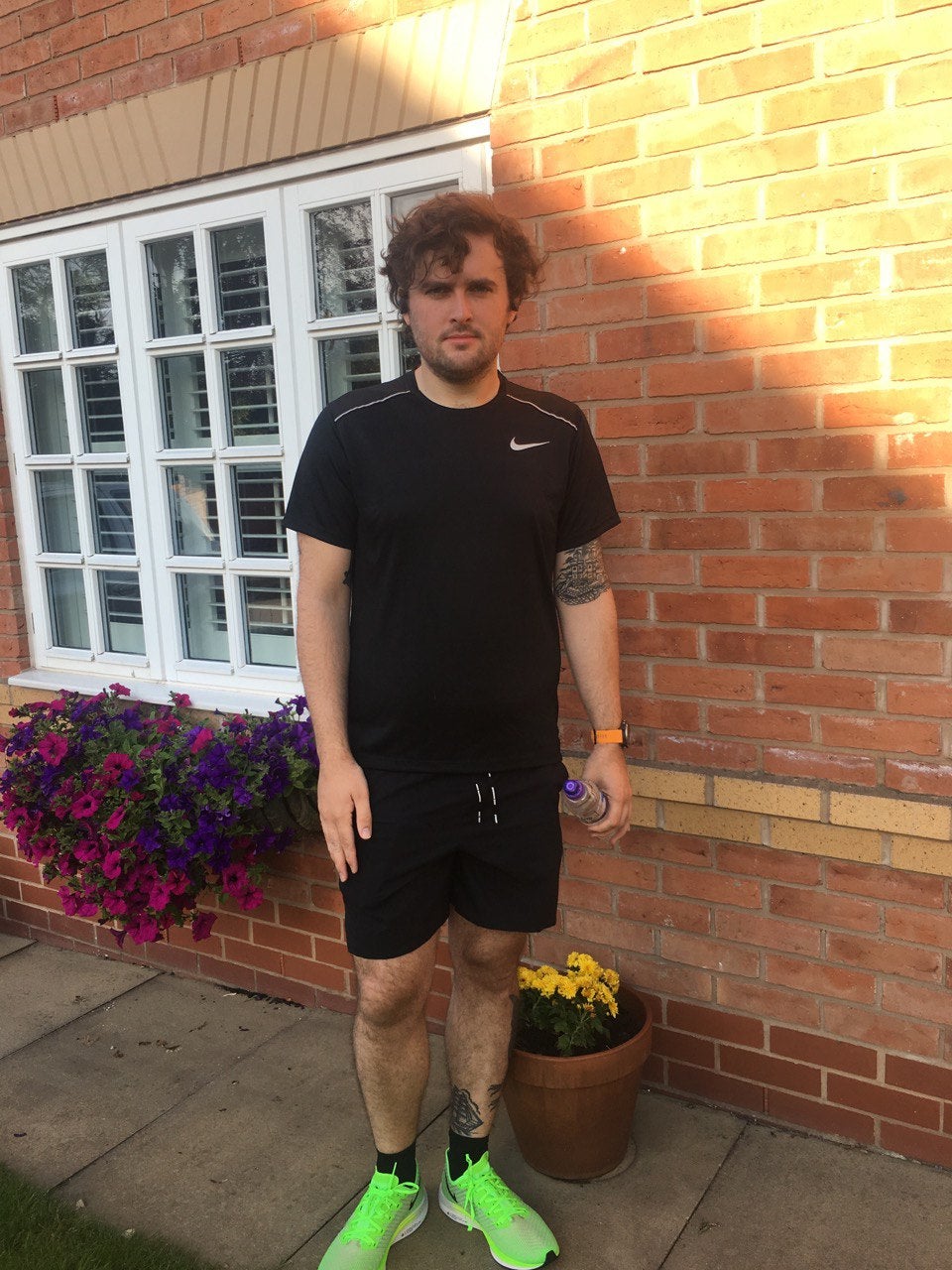
There were many good runs, of course. Once you are capable enough to appreciate it, there really is nothing like running through nature, finding your legs more fresh than you had thought, sprinting with joy at your new-found fitness. I even glimpse those transcendent, beautiful moments where you feel at one with nature; I even taste the long-promised runners’ high. Gradually grace blooms from the suffering.
There is nothing like running through nature, sprinting with joy at your new-found fitness. I glimpse those transcendent, beautiful moments where you feel at one with nature; I even taste the long-promised runners’ high
As the marathon gets nearer, you begin the taper. This means doing less, or the same amount less intensely. It works on much the same principle as those easy runs: give your body the time to recharge and recover.
It is a stressful point of the training cycle, despite how nice it might sound to finally slow down again. It requires a strange agreement of trust with your body, where you will stop running quite so much so long as it promises to make you fitter in return. There is nothing to say that it will, of course, but it just should. I’m going to stop running for a bit, you say to yourself, please use this time constructively because I’m going to be calling on you for a big favour in a week or two. It’s like praying to a god – there is no guarantee he is listening, and you just hope some miracle is waiting for you on the other side.
My taper is especially miserable. Two weeks before the marathon, I start throwing up, and I stay sick for the week that follows. I can’t walk; I can barely even stand. Eventually it passes, with just a week left, and I manage to find some kind of rhythm for the rest of the training period.
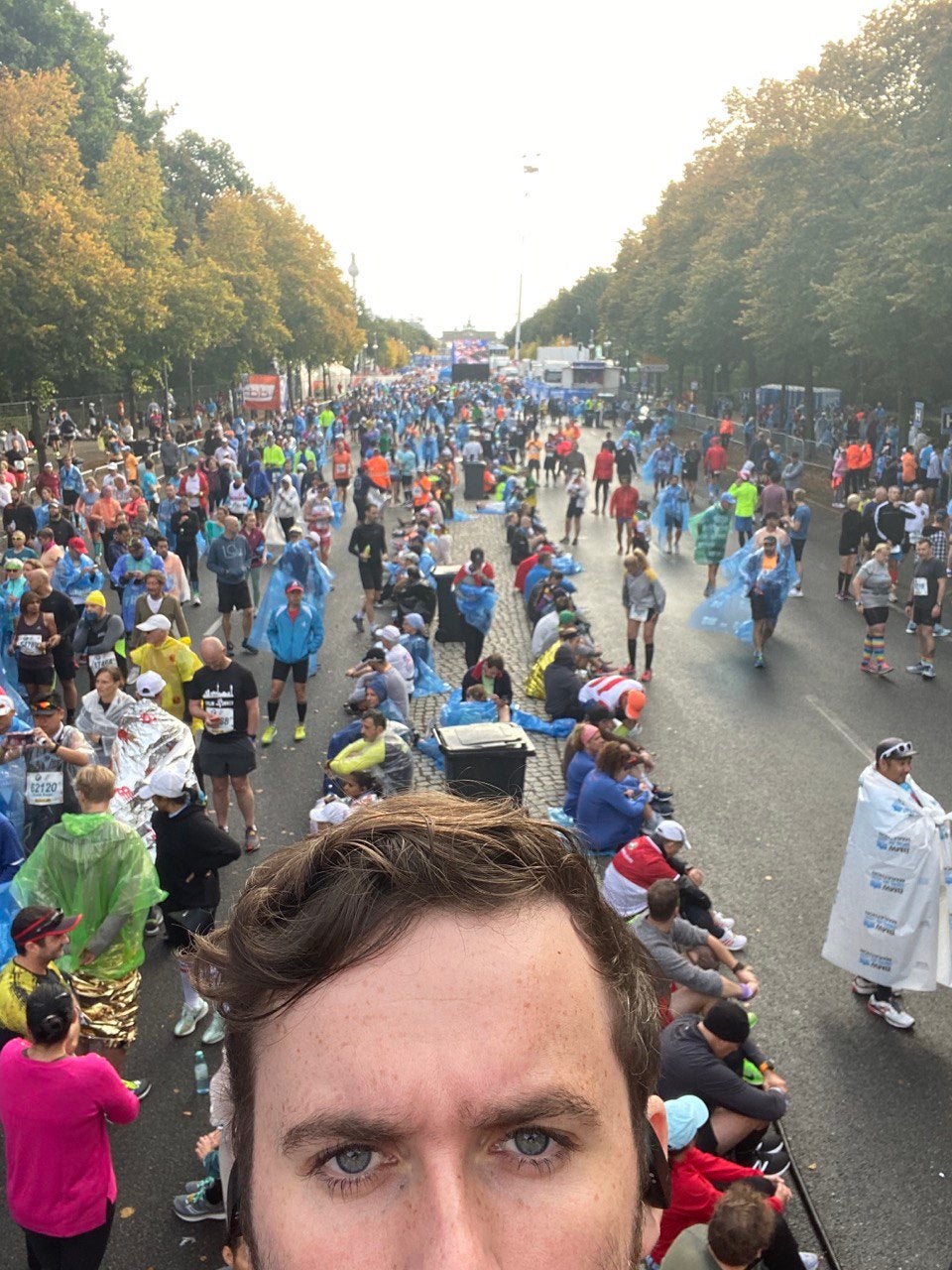
Finally, I awake to a crisp and nervous Berlin morning. Though waking implies sleep, and you do not sleep the night before your first marathon. The city has become a runner’s paradise: the streets have been cleared of cars and filled instead with people both daunted and excited. I eat simply, as instructed: a cup of coffee, a slice of bread with the thinnest spread of honey over it. My body has got all the food it needs from the endless bowls of pasta we’ve shovelled down in recent days. This is just about staving off hunger and not upsetting my stomach. It works, and I’ve hardly any appetite anyway.
I put on my running clothes, including the big number and name that I had to attach to the front of my shirt. I will run the marathon in bright pink Nike Vaporfly Next%s. These shoes have proven incredibly controversial because they feature bouncy foam and a carbon fibre plate in the sole, which means that the force from your foot hitting the floor is propelled back up, shooting you back up into the air. Critics argue that the shoes are fundamentally against the spirit of running since they artificially aid the performance of the athletes who wear them. I’m grateful for any help I can get.
Kit on and head vaguely prepared, I head for the start, which consists of a series of pens. You must wait in the pens for the staggered starting guns. And you wait for a good while, as the elites jet off. (This is a big race for elites, with the world record being set here last year; this year, it was missed by two seconds.) You can watch them on big TVs as they set off, though it’s more likely that you’re nervously jumping around trying to stay warm.
Then comes the countdown. And I am running in my first ever marathon. I feel petrified, which arrives physically: my legs won’t stop shaking, which is unfortunate when I’m relying on them so much.
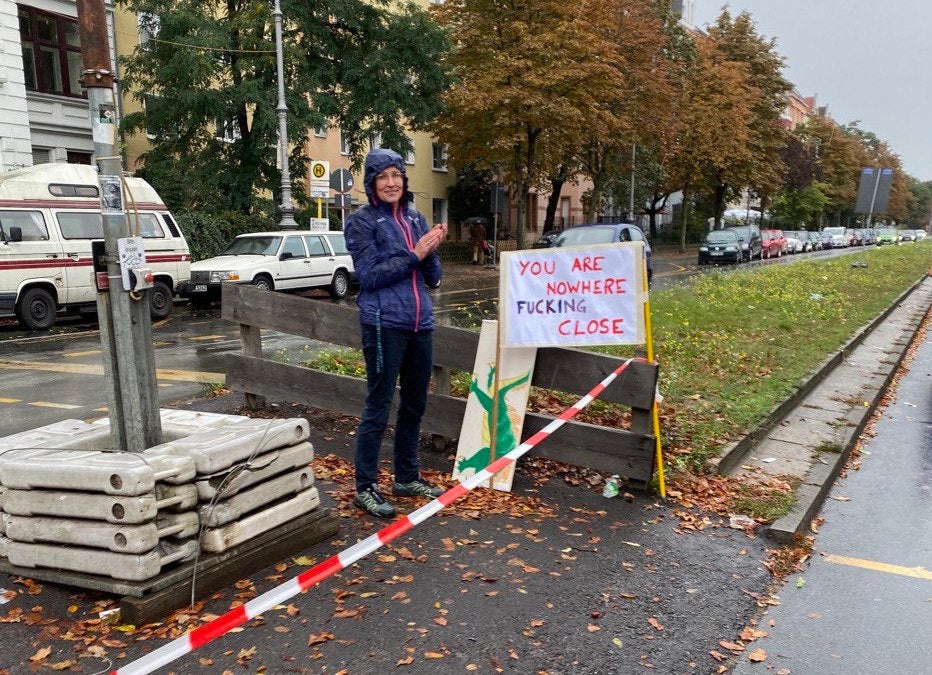
Over the next few miles, my legs start to warm up and I start to feel my way into the marathon. As I do, I’m flying. I’ve never run this well or this happily before. Running with people dramatically reduces the perceived effort it takes to get around. And the thrill of the occasion provides a jolt of energy. I’m wearing an Apple Watch, which means I can read excited messages coming in about how consistently fast I am running, and I’m so leisurely about it that I feel like I have time to reply. The first 15 or so miles are a beautiful blur.
But slowly that energy fades. I am shovelling down energy gels and blocks but I can feel myself flagging. We must keep the calorie intake up to avoid “the Wall” – or, as it is called in Germany, “the Man with the Hammer” – which arrives when your body simply doesn’t have the energy to keep going. Running becomes harder. My legs feel heavier, and full of pain.
Once you’re far enough into the race, massages are offered to runners to keep their legs feeling fresh; they happen on beds at the side of the course, which gives them the unfortunate feel of a field hospital. At a certain point, I’m so tired and cold that I can’t reach the sweets I’m carrying for energy. Some distance into the race, I see a woman carrying a sign that reminds me how far I've got to go.
As we get closer to the end, it dawns on me that the big advantage of being a fast runner in marathons isn’t the bragging rights – it’s that you’re able to finish earlier, that the pain lasts for less time. At the front of the race, Kenenisa Bekele has missed the world record by a couple of seconds, running the second-quickest race humanity has ever seen. It’s a remarkable achievement but I’m mostly envious that he completed the course before the rain started plunging down. And how it plunges. What had started out as a fine mist becomes a pounding torrent, blasts of icy chill that seem to burrow deep into your bones. We are only halfway through and it carries on through the rest of the race.
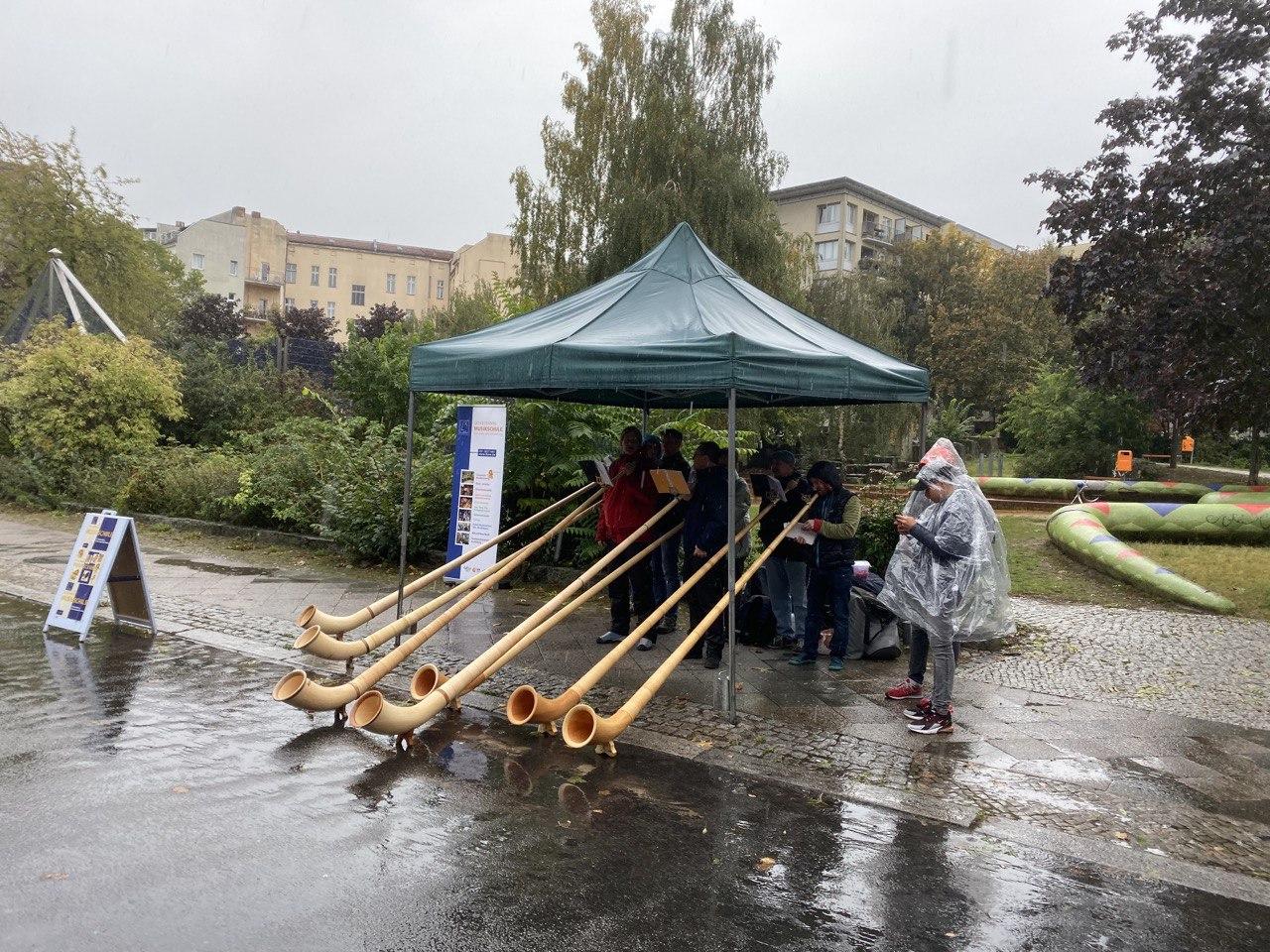
I had been considering the rest of the run in a fairly crude, mathematical way: at 13.1, I congratulated myself on making it to the half, and I’d count off the progress as we went along: now five-eighths of the way through, now two-thirds, and now three-quarters. Working out the increasingly complicated fractions proved a neat distraction, and the shrinking proportions that were left provided some solace.
But I had made a fatal mistake. Not all kilometres are equal. As you run, they grow, and do so at an unsettling speed. Sometimes they even seem to repeat: I was sure I passed the 39km marker twice. Having two miles left is, rationally, being nearly there. But when you are that far in, they feel roughly equivalent to running a whole marathon all over again.
The human body is made for running a long way, and getting three quarters of the way through a marathon suggests the body is fairly good at it, even without a great deal of preparation. But three quarters feels about right. After that, the body screams: why are we doing this, what are we here for?
As we go into mile 24 this becomes very clear. My splits had been alarmingly regular up until this point: the first mile took 9 minutes 41, and the 21st took 9 minutes 43. But towards the end the speed starts to plunge: mile 25 takes 12’49” and then mile 26 takes 13’18. Really, the additional time is minor; but those minutes drag by as my legs ache and my muscles squeal. At around 24 miles, I permit myself to stop running for the first time, and the relief of so doing is matched by the fear that I might never start again.
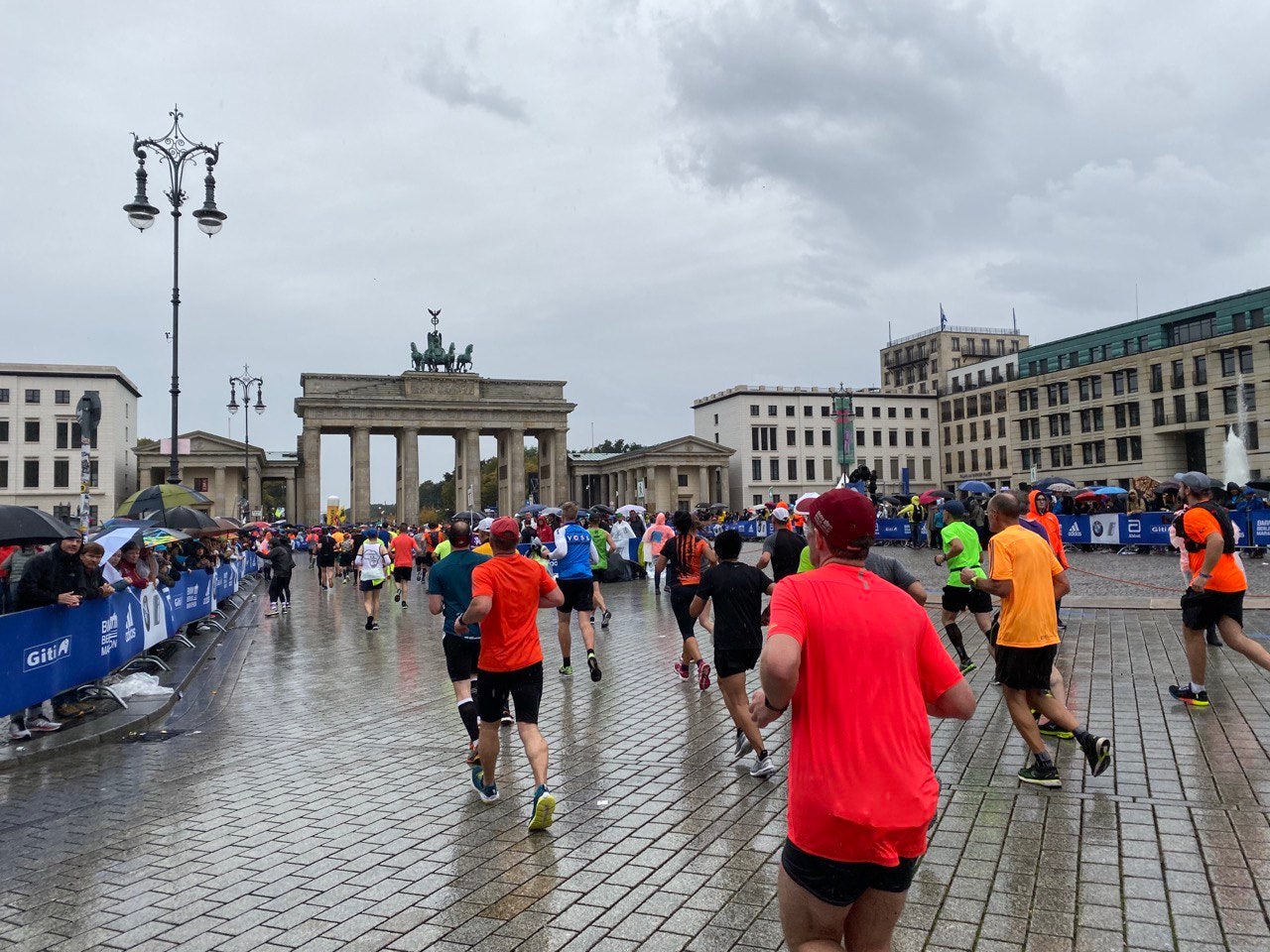
But my shoes keep me going. In a real physical sense, they make it difficult to settle for long, because their bouncy soles and forward lean mean they’re more comfortable to be moving in than standing still. In a slightly more stupid but probably more powerful sense, they make me want to go because they are bright pink. Everyone knows they are worn by the elite. I am stood by the side of the road looking distinctly un-elite, and feel very stupid. And then here, all of a sudden, is the end. My watch is blaring to say I’m almost done, and the Brandenburg Gate is visible. I’m through it, and somehow finding a last-minute surge to the finish line, sprinting and hurting and sprinting. And then I cross over the big mat that will register me as having finished, count my time and complete my race.

It is done. I am done. A wave of relief crashes over me, then a wave of pain, then a wave of cold. I am profoundly happy, hungry, sick and satisfied. The main thing I notice is the sheer quantity of feelings, so many and with such power that I don’t really know what any of them are. Everyone I talk to asks how it went. And all I can say is: good, not good, and then good. The first good lasted 20 miles. The not good lasted an hour. The final good lasts forever. And that is where I remain now: relishing the splendour of the hard won finish line. But I can’t remain there for long, and almost as soon as the marathon is over I start looking for new ones to do, new challenges to complete, new speeds and times to beat. Although I refuse to admit it to myself, I realise I don’t hate running. I might even love it. I’m a runner.
Join our commenting forum
Join thought-provoking conversations, follow other Independent readers and see their replies
Comments